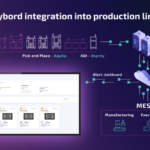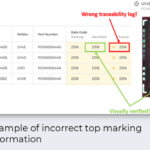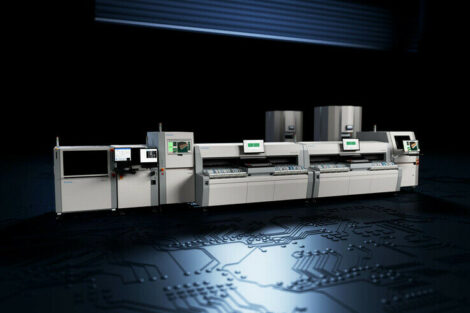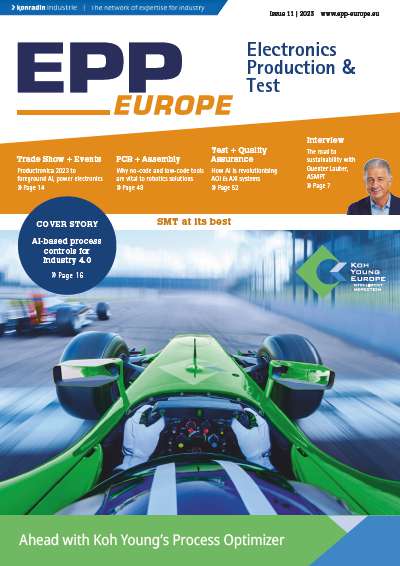EPP Europe: Hi Oshri, could you start by telling us how Cybord was founded, and how you came to be CEO.
Oshri Cohen: Our CTO Dr. Eyal Weiss founded the company in 2019. Before that, he was leading a multi-million-dollar defence project here in Israel. After 15 years’ work on the project, they eventually began to deploy the system out in the field, but suddenly found that a lot of the units were failing. When they investigated this, they discovered there was one particular capacitor that was defective – that had cost just one cent – that was causing all these units to fail. And he realized that nobody was testing or even looking at the components before the boards were being assembled. This made Eyal think, “OK with my knowledge of AI and big data, I‘m going to change the world – I‘m going to change the way supply chain works.” That’s how he came to found Cybord.
When I joined the company in 2022, my back was also figuratively covered in scars because of defective components getting into products. In my previous role as VP Supply Chain at Mellanox and then Nvidia, I had had to deal with a lot of very painful recalls and reworks. It was a disaster. I thought that getting into something new involving AI and Big Data and, at the same time, actually resolving a real problem in the supply chain was a great idea.
Can you explain a bit about the technology you use, exactly how it works and what it involves…
Yes, but first I’ll explain the problem that we are addressing. Today when you try to assemble a PCB, there are two main challenges. The first is controlling the assembly process. This, as we know, is something already well covered by great companies like ASM, Fuji, Vitrox and Koh Young. The other is controlling the materials used – the actual electronic components. This is something that has been almost completely neglected over the last 10–15 years – not because people didn‘t want to tackle it, but because it was almost impossible to resolve. There are hundreds of millions of different types of components available on the market. A single production line assembles on average around a million components per day. How can you track all of them? A whole factory in a month produces a few billion components. There wasn’t a database capable of dealing with this. This has now changed. We now have artificial intelligence – meaning we are able to train models to learn hundreds of millions of different types of components. And we have Big Data. So finally we are able to collect data on hundreds of millions of components in the same database and the system will continue to run smoothly.
So what exactly does Cybord offer customers? And how is your technology integrated into existing machinery in SMT lines?
Cybord is purely a software company. If we tried to sell a hardware-based solution, nobody would adopt it. This is a very conservative industry. Most are not willing to change their line layouts. They are not willing to spend money, nor do they want to add additional processes to lines as it would reduce throughput. So we integrate our software into existing lines. And we do this in two positions: pick-and-place machines and AOI systems. We integrate our software through API into these machines. Pick and place machines already automatically take a picture of each and every component from the bottom side. We connect to these systems using APIs to get all the images – including the metadata – from the machine. Then ultimately we utilize all this information to run very sophisticated, smart and fast AI algorithms to analyse every component in order to tell the system, “this one is a good one”, “this one is a bad one,” “this is an anomaly because there is corrosion or there is mould,” and so on. This software capability we have is called ‘Aquila’.
We also work with AOI system manufacturers to analyse images of components from the top in order to provide a different kind of analysis. Using images taken from above, we decode the marking with our NLP technology. We are able to collect and visually verify traceability information in order to see which component was assembled into which board. Then we can provide this very accurate traceability data to the customer. This capability we have is called Osprey.
Can you integrate your software into any brand of machinery, or are there only specific companies you work with?
That‘s an excellent question. As I explained, we base our technology on the data obtained from a machine API. So, for example, we partner with ASMPT, with Fuji, with Yamaha. On the AOI side, we partner with Koh Young, Vitrox and Holly. So the biggest ones we are already connected to, but there are some that we are not yet connected to. Of course, we would like to expand to everyone, but we prefer to wait until there is a case with a specific customer for another brand and then we will build the interface tailored to that system.
What happens if the software comes across a new component that the AI is not familiar with?
Yeah, it happens. We need between 1000 and 5000 components to build a model. Building a model doesn‘t mean that people are sitting here and building models. The AI builds the model by itself. It just needs a lot of information to do it. To give you a sense of the speed – 5000 components of the same type can run in 30 minutes. Once the AI has seen 5000, it can build a very accurate model. If anything is wrong with the model, we have people here providing annotations to it, so it improves and improves until we have a good stable model. Once we have this – let‘s say it takes half a day to build – we are, from that point, able to scan that component.
So you build the model centrally and then it gets automatically integrated into your software so that everybody using your solution has access to it?
Exactly.
And does the AI keep learning about that component? After you‘ve got 5000 images, does it keep adding new ones to the model?
Yes – but only until we get to an accuracy level of 99.9%. After that we stop training the AI because it’s not efficient.
How big is your database now?
We have 4 billion components in our database. There are a few hundreds of millions of different components out there, so we have a way to go. We are now integrated into 60 lines across the globe. This means we see new components every day and we are increasing our database exponentially. We are connected to these facilities, collect information and monitor it live. At the end of the day, everything that has been collected from one customer can be used by others.
If you are using photographs rather than x-rays, how can you see inside the component if there‘s anything wrong?
We don‘t need to see anything inside. In 80% of cases, the component will contain some marking outside of it. Sometimes it is bent legs, sometimes corrosion, sometimes a small crack. Often customers say, “OK, you guys see corrosion. I don‘t care about corrosion.” But although the corrosion may not be a problem, it often indicates a problem inside the component – delamination, for instance, or a cracked die. Corrosion cracks, chipped terminals, whatever signs we see outside, we cover more than 80% of the defects that can happen inside.
Are there any blind spots because you can‘t see inside? Do you miss things?
Almost none. In fact, sometimes, when the model is still young, we overshoot. It can happen that we say there is a problem and there isn’t a problem, but that‘s OK because once we have trained the model to attain 99.9% accuracy then we get almost no false positives.
You call Cybord‘s technology “industry-disrupting”. Can you elaborate on this?
Today, companies often budget 2.5–3.5% of their cost of goods sold for warranty expenses. If we are able to see and react to issues with components on the line during assembly, these companies do not need to keep spending this capital. Up until now, if there is a failure in their boards, they find out – in the best case – at the end of the process. In the worst case, they don‘t find the failure at all. They deliver the product to market and then they get a failure in the field – leading to a painful recall. The automotive industry, for instance, has USD 50 billion of warranty claims every year. Not all of this is related to electronics, but 22% of it is. Now, if you assume just 80% of these issues can be resolved by our software, then USD 8 billion can be saved in this industry every year. This is why our technology is so disruptive. We don‘t ask you to invest capital. We don‘t ask you to hold your line or to reduce your throughput. We don‘t ask you to cause any delays. We just ask you to buy a subscription – which is fairly cheap. We don‘t even ask you to employ people to look at the results. We connect directly to the shop floor management system and we communicate with the system to flag up suspect boards which can then be removed from the line and dealt with later. That‘s where we are taking the industry and that‘s just a revolution.
So do you think that everybody in the industry needs to adopt this technology?
You know – it depends what you‘re doing. If you are producing toys and reliability is not very important, then you shouldn‘t. If you‘re running an aerospace business, automotive, medical, data centre, storage – you name it – you need to have this capability inside your lines, otherwise you will keep spending on recalls and reworks and product reliability will be low.
You said that nobody‘s done this before because the technology didn‘t exist. How easy was it for you to develop? Is anyone else doing something similar?
It took two years to build the algorithm. But the name of the game here is not just the algorithm. The name of the game is the size of your database. AI has a lot of advantages, but the main disadvantage is, if you don‘t have humongous database, it doesn‘t work. You need time to build your database and until you do this, you cannot begin running these algorithms. Even if someone decided today they would like to start competing with us, they will need some time to build their database. It took us 2.5 years to build our database.
I have to tell you that as great as it sounds that we don‘t have competition – actually I would prefer to have competition.
Why is that?
Because that way I wouldn‘t be the one that needed to educate the market. So many customers think what we are offering must be too good to be true. I‘m saying, “hey guys, this is what you‘re getting” and they all say, “Huh? I don‘t believe you – you need to prove that this dream you’re selling is real.” They think – how can it not cost me very much and prevent all these failures? It’s something so new and so innovative that they can‘t accept it – so it takes some time to convince them. The beauty is, though, once you sign the agreement, the technology is very sticky. People get addicted to its capabilities and say, “I can‘t believe I couldn‘t see this up until today.”
What can you tell us about your newest product – real-time quality assurance? How does this work and how will it benefit the industry?
Our newest product is called the Peregrine. The peregrine is the fastest bird in the world. Until now, we have taken all the images and uploaded them to the cloud, and our software is able to react within 10 seconds to a problematic component in the line. With this new product, which we released recently, we are moving the computing power from the cloud to the edge. The server where the computer runs all the algorithms is going be in the factory itself, not on the cloud. This means it will be able to react within six milliseconds, rather than 10 seconds, to an issue. The program can analyze the images so rapidly that it can tell the machine to dump faulty components before they are even placed on the board.
Can this be integrated into any machine?
The beauty here is that we provide this capability through an open API system, so every manufacturer just gets the API, and they integrate it to their software themselves. The incentive for our partners is their assembly machines are gaining, for the first time ever, the capability to sort components.
How do you see the future of electronics manufacturing? And how do you see the future of Cybord?
Well, I tie one to the other. The future of electronics manufacturing is going to be unbelievably bright because the world is becoming more and more technological. The electronics industry is already growing 3 to 4% every year and it will grow even more. This means that if we are able to keep deploying in the field with our customers, you will also see Cybord growing proportionally. You cannot deploy technology without assembling boards, without assembling hardware. No matter how great your software is, you will still have to rely on some hardware, right? As long as you build hardware, you will need Cybord.













